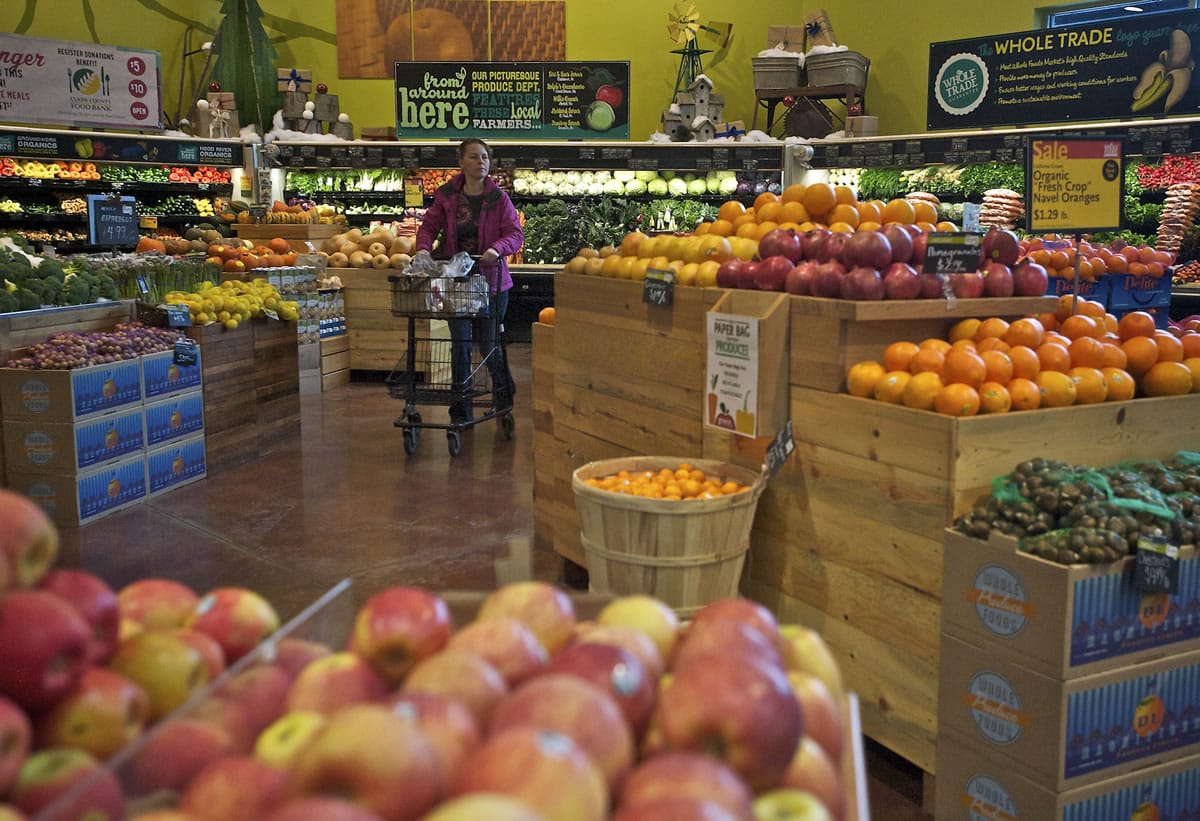Whole Foods Markets operates 18 stores in a Northwest region that encompasses Washington, Oregon and British Columbia, and includes a Vancouver store at 815 S.E. 160th Ave., said Susan Livingston, the Seattle-based regional retail marketing manager. The grocer expects steady growth in the region, including the Portland-Vancouver area, but Livingston said she could not offer any specifics. She said the Vancouver store has been heavily involved in local partnerships with community groups, reflecting the Austin, Tex.-based company’s desire to engage with local organizations and to offer products and services distinct to each community.
AUSTIN, Texas — There’s no doubt about it — Whole Foods Markets Inc. is growing faster than ever.
But while the Austin-based natural foods grocer is stepping on the gas, the company also faces more competition than ever — both from rival natural foods chains and traditional supermarkets that are increasingly stocking similar products.
Company officials say they aren’t afraid of competition, though, and analysts say Whole Foods remains the biggest player in the natural and organic food market.
Whole Foods Markets operates 18 stores in a Northwest region that encompasses Washington, Oregon and British Columbia, and includes a Vancouver store at 815 S.E. 160th Ave., said Susan Livingston, the Seattle-based regional retail marketing manager. The grocer expects steady growth in the region, including the Portland-Vancouver area, but Livingston said she could not offer any specifics. She said the Vancouver store has been heavily involved in local partnerships with community groups, reflecting the Austin, Tex.-based company's desire to engage with local organizations and to offer products and services distinct to each community.
This fiscal year promises to be the biggest ever for Whole Foods, growth-wise. The company currently operates nearly 370 stores and officials plan to open up another 33 to 38 stores in the current fiscal year.
Jim Sud, Whole Foods’ executive vice president for growth and business development, said the number of new stores would be a record for the store.
One of the reasons for the growth — aside from improving economic conditions — is the company learned it can successfully operate stores in smaller markets. Through its acquisition of Wild Oats, the company acquired stores in such locations as Tulsa, Okla., and Park City, Utah — areas “which were never really on our target list,” Sud said.
Those successes, combined with the rising cultural awareness of healthy eating, gave the company confidence that it could look into smaller markets, he said.
“As the company has grown over the years, our brand has strengthened and I think that’s the result of people having more exposure to Whole Foods and certainly the growth and awareness in natural and organics and healthy lifestyles,” he said.
“We’re seeing our stores in new markets open at higher (sales) volumes than historically. So we think we’ve got a really good runway for growth,” Sud said.
Company officials have said Whole Foods could reasonably reach 1,000 stores, but Sud said they now think that’s a conservative estimate, implying the company could grow to even more.
“We need to grow at a pace that does not outstrip our ability to effectively operate the stores and at a pace that doesn’t have a negative impact on our culture,” he said. “Because our team members are absolutely the key to our successes.”
But even as Whole Foods grows, the company faces challenges and a recent slowing of sales that spooked Wall Street.
Whole Foods is grappling with rising competition from such specialty grocers as Sprouts Farmers Market, as well as mainstream chains such as Kroger Co. that have added upscale provisions to their shelves.
Whole Foods last month cut its fiscal 2014 profit and revenue forecasts amid slowing sales growth. Sales at stores open at least a year rose 5.9 percent in the company’s 2013 fiscal fourth quarter, which ended Sept. 29, the slowest pace in 15 quarters.
“We are not immune to the larger macro environment,” co-CEO John Mackey said at the time. “Discretionary spending has been impacted as consumer confidence has dropped to a six-month low.”
In response, the stock was downgraded by investment firm Goldman Sachs.
“While we still view (Whole Foods) as a secular winner with continued opportunity for store growth and margin expansion, we are lowering our comp estimate to reflect the softer top-line trajectory relative to broader industry trends,” Goldman analyst Stephen Grambling wrote.
The company’s same-store sales growth “has recently deviated from specialty peers, distributors and manufacturers, suggesting the macro (environment) is not the sole driver of softer trends,” Grambling’s report said.
Those specialty peers are growing. Sprouts now has more than 160 stores in eight states — up from 104 stores early last year.
Trader Joe’s has at least 400 stores in 35 states — up from about 360 two years ago.
Brian Yarbrough, an industry analyst for Edward Jones, said the natural/organic space has gotten more crowded.
“The regular traditional grocery stores are trying to do a little bit better job with organics,” he said. “I know Target’s been adding more organics to their offerings. Even some of the drugstores — that’s not as comparable, but they’re trying to add organics and things like that.”
And competitors like Sprouts are looking to grow rapidly, he said.
Still, “at the end of the day, the customer service and the products (Whole Foods) provides, in my opinion, is a step above anyone else,” Yarbrough said.
Ten or 20 years ago, Whole Foods could deal with rising competitors by acquiring them, said Andrew Wolf, an analyst with BB&T Capital Markets. But he doesn’t see that happening again.
“It’s still a growth company; it’s just not to the same extent as previously,” Wolf said.



